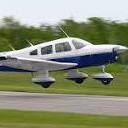Taxi645 wrote:vikkyvik wrote:Taxi645 wrote:Thank you. I'm asking because we were having a discussion whether or not weight (as in design weight) could have an influence on the induced drag coefficient or not.
Weight will affect induced drag, since weight affects the amount of lift required.
Taxi645 wrote:I would argue, for instance in the case of the A380 and a possible wing redesign, that at a given wing loading and span, a reduction in design weight will result in a higher aspect ratio and thus lower induced drag. Could you confirm whether or not this to be the case?
A reduction in design weight doesn't automatically mean a higher aspect ratio. Aspect ratio is a property of the wing geometry (span^2 / area).
But it does proportionally affect aspect ratio if you keep span and wing loading constant.
I think you may be confusing yourself on this topic and/or not connecting a few of the dots. Let's see if we can help:
For starters, let's show the definitions/formulas of the key variables:
Aspect Ratio (AR) = (Effective Wingspan^2) / Wing Area.
Spanloading = MTOW / Effective wingspan
Wingloading = MTOW / Wing Area
Induced Drag = 0.5*(air density)*(Velocity^2)*(Wing Area)*(Induced Drag Coefficient)
To start answering your questions, in order:
1) For starters, none of the sources you posted are conflicting, though I can see how the might appear to be. For the purpose of explaining how aspect ratio, spanloading, and induced drag are related, let's start on Wainfan slide #34. This will be challenging to explain via written text, without showing the formulas, but here it goes;
Start with the formula for induced drag, which I posted above: Induced Drag = 0.5*(air density)*(Velocity^2)*(Wing Area)*(Induced Drag Coefficient)
At the top of page 34, Wainfan correctly give the formula for the Induced Drag Coefficient = (Lift Coefficient ^ 2) / [(Pi)*(Span Efficiency Factor)*(Aspect Ratio)]. This is where the Leeham analysis stops - from here, you can see that because Aspect Ratio is in the denominator, increasing Aspect Ratio means you have a corresponding decrease in the Induced Drag Coefficient, which will decrease overall Induced Drag. Per the formula for Aspect Ratio I defined above, there are only two ways to increase Aspect Ratio: either make the area of the wing smaller for a given wingspan, or make the span of the wing longer for a given wing area. Leeham is saying that by increasing the span of the wing, you will lower induced drag, because a longer wingspan leads to a higher Aspect Ratio, which in turn decreases the Induced Drag Coefficient.
Wainfan goes one step further, and plugs the formula for the Induced Drag Coefficient back into the Induced Drag Formula. This is on the middle of slide #34. Wainfan works through the algebra to get to a final formula for Induced Drag, which is boxed and bolded at the bottom of the page. From this, you can see that two key terms appear in the numerator and denominator: (Lift^2) / (Wingspan^2). From our aerodynamics basics, we know that in steady, level flight, Lift = Weight, so we can rewrite that as (Weight^2) / (Wingspan^2). Notice anything familiar about this term? If you take the square root of it, you have Weight / Wingspan, which is the exact formula I posted above in the "definitions" for wingloading.
Therefore: to decrease the induced drag of a wing, you must increase the aspect ratio of the wing, or minimize the spanloading of the wing. The way to achieve both a higher aspect ratio and lower spanloading is to increase the wingspan.
2) You are on the right path with your A380 example and the relationship between spanloading, aspect ratio, and wingloading. If you want to hold Wingloading
constant, while decreasing the design weight of the aircraft, then you
must reduce the area of the wing. If you reduce the area of your wing, while keeping wingspan constant, hen you will have increased your aspect ratio. By keeping the wingspan constant, and reducing the weight of the aircraft, you have decreased your spanloading. Per my last sentance in #1 above, increasing aspect ratio / decreasing spanloading will have the effect of reducing induced drag.





